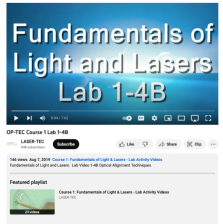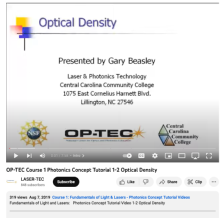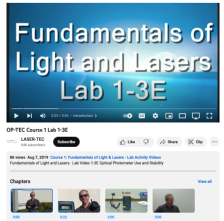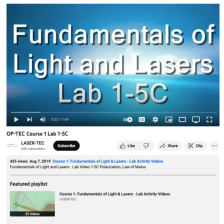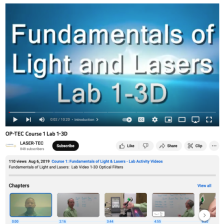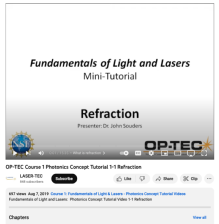Browse Resources
Resources |
|---|
This lab activity, presented by John Chamberlain, focuses on the measurement of beam diameter and divergence from a laser. In this 14-minute video, Chamberlain demonstrates the set-up for the lab, including how to properly read a micrometer, and taking the necessary micrometer and power readings to...
This lecture, presented by John Souders, covers the basics of metastable states and stimulated emission. Souders begins the lecture on the white board, demonstrating equations and charts related to metastable states and stimulated emission. Discussed are concepts such as mechanics, atomics, and...
This lab activity, presented by John Chamberlain, demonstrates techniques for optical alignment that will be useful to students in completing subsequent laboratory activities in this series. In the seven-minute video, Chamberlain shows both the rough and fine horizontal adjustment of a laser beam to...
This lecture, presented by Gary Beasley, covers the basics of optical density as the concept relates to the fundamentals of light and lasers. In 7 minutes, Beasley covers the definition of optical density (a measure of how much light can be transmitted through a specimen or substance), provides...
This lab activity, presented by John Chamberlain, demonstrates the use of a photometer. In this six-minute video, Chamberlain uses the photometer to take readings of the sun's light as well as a reading of a helium neon laser beam. This three-part lab, 1-3E, is one in a series of 20 available on the...
This lab activity, presented by John Chamberlain, focuses on Malus' law and the angle between two polarizing filters. In this 8-minute video, Chamberlain demonstrates the set-up for the lab and the process of taking measurements with an analyzer in order to calculate predicted angles. This lab, ...
This lab activity, presented by John Chamberlain, teaches students to measure the power transmitted from a helium neon laser through various colored filters. In the 10-minute video, Chamberlain demonstrates the process by shining a laser through various colored filters, including blue, yellow,...
This lab activity, presented by John Chamberlain, examines the effects of prisms and lenses on light emitted from a laser. In first part of the twelve-minute video, Chamberlain demonstrates refraction of light through a prism, and the measurement and calculation of the angle of deviation produced...
This lecture, presented by John Souders, covers the basics of refraction as the concept relates to the fundamentals of light and lasers. In 15 minutes, Souders defines refraction (the bending of a light wave when it passes from one medium to another) and describes the conditions necessary for...
This lab activity, presented by John Chamberlain, covers the the polarization of light using filters. In this four-minute video, Chamberlain demonstrates the use of a flashlight, stand, reflective surface, and polarizing filters (including one used as an analyzer) to examine planes of polarization. ...
|
| ← PreviousNext → |


